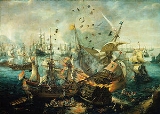
Battle of Gibraltar
Encyclopedia
The naval Battle of Gibraltar took place on 25 April 1607 during the Eighty Years' War when a Dutch
fleet
surprised and engaged a Spanish
fleet anchored at the Bay of Gibraltar
. During the four hours of action, most of the Spanish fleet was destroyed.
. The Dutch flagship was Æolus. Other Dutch ships were De Tijger (The Tiger), De Zeehond (The Seal), De Griffioen (The Griffon), De Roode Leeuw (The Red Lion), De Gouden Leeuw (The Gold Lion), De Zwarte Beer (The Black Bear), De Witte Beer (The White Bear) and De Ochtendster (The Morningstar).
The Spanish fleet of 21 ships, including 10 galleons was led by Don Juan Álvarez de Ávila. The Spanish flagship San Augustin (St Augustine) was commanded by Don Juan's son. Other ships were Nuestra Señora de la Vega (Our Lady of Vega) and Madre de Dios (Mother of God). The Spanish fleet was covered by a fortress, although the Dutch fleet was out of range of its guns at all times and they could not intervene in the battle .
ball severed his leg. The Dutch effectively then doubled up the galleons (in a move that almost two centuries later was copied by Admiral Nelson during the Battle of the Nile
of 1798) and a few of the galleons caught fire. One Spanish ship exploded due to a shot into the powder magazine. The Dutch captured the Spanish flagship, but let it go adrift.
Following the destruction of the Spanish ships, the Dutch deployed boats and killed hundreds of swimming Spanish sailors. The Dutch lost 100 men including admiral Van Heemskerk. 60 Dutch were wounded. The Spanish lost most or their entire fleet and between 350 and 4.000 men killed or captured. Álvarez de Ávila was amongst the dead.
Netherlands
The Netherlands is a constituent country of the Kingdom of the Netherlands, located mainly in North-West Europe and with several islands in the Caribbean. Mainland Netherlands borders the North Sea to the north and west, Belgium to the south, and Germany to the east, and shares maritime borders...
fleet
Naval fleet
A fleet, or naval fleet, is a large formation of warships, and the largest formation in any navy. A fleet at sea is the direct equivalent of an army on land....
surprised and engaged a Spanish
Spain
Spain , officially the Kingdom of Spain languages]] under the European Charter for Regional or Minority Languages. In each of these, Spain's official name is as follows:;;;;;;), is a country and member state of the European Union located in southwestern Europe on the Iberian Peninsula...
fleet anchored at the Bay of Gibraltar
Bay of Gibraltar
The Bay of Gibraltar is a bay at the southern end of the Iberian Peninsula. It is around long by wide, covering an area of some , with a depth of up to in the centre of the bay...
. During the four hours of action, most of the Spanish fleet was destroyed.
Forces
The Dutch fleet of 26 warships was led by Jacob van HeemskerkJacob van Heemskerk
Jacob van Heemskerk was a Dutch explorer and later admiral commanding the Dutch fleet at the Battle of Gibraltar.-Arctic exploration:...
. The Dutch flagship was Æolus. Other Dutch ships were De Tijger (The Tiger), De Zeehond (The Seal), De Griffioen (The Griffon), De Roode Leeuw (The Red Lion), De Gouden Leeuw (The Gold Lion), De Zwarte Beer (The Black Bear), De Witte Beer (The White Bear) and De Ochtendster (The Morningstar).
The Spanish fleet of 21 ships, including 10 galleons was led by Don Juan Álvarez de Ávila. The Spanish flagship San Augustin (St Augustine) was commanded by Don Juan's son. Other ships were Nuestra Señora de la Vega (Our Lady of Vega) and Madre de Dios (Mother of God). The Spanish fleet was covered by a fortress, although the Dutch fleet was out of range of its guns at all times and they could not intervene in the battle .
The battle
Van Heemskerk left some of his ships at the bay entrance to prevent the escape of any Spanish ship.Twenty of the Dutch attacking ships were ordered to focus on the Spanish galleons while the rest attacked the smaller vessels. Van Heemskerk was killed during the first approach on the Spanish flagship as a cannonCannon
A cannon is any piece of artillery that uses gunpowder or other usually explosive-based propellents to launch a projectile. Cannon vary in caliber, range, mobility, rate of fire, angle of fire, and firepower; different forms of cannon combine and balance these attributes in varying degrees,...
ball severed his leg. The Dutch effectively then doubled up the galleons (in a move that almost two centuries later was copied by Admiral Nelson during the Battle of the Nile
Battle of the Nile
The Battle of the Nile was a major naval battle fought between British and French fleets at Aboukir Bay on the Mediterranean coast of Egypt from 1–3 August 1798...
of 1798) and a few of the galleons caught fire. One Spanish ship exploded due to a shot into the powder magazine. The Dutch captured the Spanish flagship, but let it go adrift.
Following the destruction of the Spanish ships, the Dutch deployed boats and killed hundreds of swimming Spanish sailors. The Dutch lost 100 men including admiral Van Heemskerk. 60 Dutch were wounded. The Spanish lost most or their entire fleet and between 350 and 4.000 men killed or captured. Álvarez de Ávila was amongst the dead.

